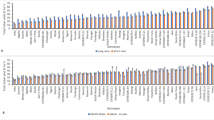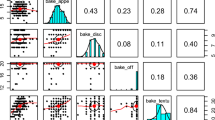Abstract
Tuber yield, together with tuber number and size are the basic agronomic and breeding traits in Jerusalem artichoke and can be significantly affected by environmental factors. We report the results of a long term trial on the performance of 20 Jerusalem artichoke cultivars. The random model for means with restricted maximum likelihood (REML) procedure was used to estimate the overall effects of the genotype, environment and genotype by environment interaction on traits. The partial least square regression (PLSR) model was used for modeling genotype by environment interaction variance components with a set of available correlated environmental variables. The REML variance component estimates model revealed that tuber number and yield are more dependent on GE interaction which allowed identification of best genotypes for specific environments. The PLSR model revealed that the most important climatic variables for optimal emergence, canopy development, high tuber number and yield are adequate soil and air temperatures in April. For larger tuber mass, precipitation variables and even distribution of rainfall were the most important factor, together with soil and air temperature in June when tuber growth is initiated. The knowledge obtained in this study is valuable for the identification and understanding of key environmental factors that contribute to the performance of Jerusalem artichoke.






Similar content being viewed by others
References
Annicchiarico P (2002) Genotype × environment Interactions: challenges and opportunities for plant breeding and cultivar recommendations. Food and Agricultural Organization, Rome
Baldini M, Danuso F, Monti A, Amaducci MT, Stevanato P, De Mastro G (2006) Chicory and Jerusalem Artichoke productivity in different areas of Italy, in relation to water availability and time of harvest. Ital J Agron 2:291–307
Baldini M, Francesco D, Alvaro R, Elena B, Monti A, Giuseppe DM (2011) Jerusalem artichoke (Helianthus tuberosus L.) productivity in different Italiangrowing areas: a modelling approach. Ital J Agron 6:126–132
Cosgrove DR, Oelke EA, Doll DJ, Davis DW, Undersander DJ, Oplinger ES (2000) Jerusalem Artichoke. http://www.hort.purdue.edu/newcrop/afcm/jerusart.html. Accessed 5 Jan 2016
Crossa J (2012) From genotype × environment interaction to gene × environment interaction. Curr Genom 13:225–244
Crossa J, Burgueño J, Vargas M (2010) Statistical models for studying and understanding genotype × environment interaction in an era of climate change and increased genetic information. In: Reynolds M (ed) Climate change and crop production, CABI Climate Change Series. CIMMYT, Mexico, pp 263–283
Janket A, Jogloy S, Vorasoot N, Kesmala T, Holbrook C, Patanothai A (2013) Genetic diversity of water use efficiency in Jerusalem artichoke (Helianthus tuberosus L.) germplasm. Aust J Crop Sci 7:1670–1681
Kang MS (2004) Breeding: genotype-by-environment interaction. In: Goodman RM (ed) Encyclopedia of plant and crop science. Marcel Dekker, New York, pp 218–221
Kays SJ, Kultur F (2005) Genetic variation in Jerusalem artichoke (Helianthus tuberosus L.) flowering date and duration. HortScience 40:1675–1678
Kays SJ, Nottingham SF (2007) Biology and chemistry of Jerusalem artichoke (Helianthus tuberosus L.). CRC Press, Boca Raton
Kocsis L, Kaul H-P, Praznik W, Liebhard P (2007) Influence of harvest date on shoot and tuber yield of different Jerusalem artichoke (Helianthus tuberosus L.) cultivars in the semiarid production area of Austria. Ger J Agron 11:67–76
Kocsis L, Kaul H-P, Praznik W, Liebhard P (2008) Influence of harvest date on tuber growth tuber dry matter content, inulin and sugar yield of different Jerusalem artichoke (Helianthus tuberosus L.) cultivars in the semi-arid production area of Austria. Ger J Agron 12:8–21
Malosetti M, Ribaut J-M, van Eeuwijk FA (2013) The statistical analysis of multi-environment data: modeling genotype-by-environment interaction and its genetic basis. Front Physiol 4:1–17
Paungbut D, Jogloy S, Vorasoot N, Patanothai A (2015) Growth and phenology of Jerusalem artichoke (Helianthus tuberosus L.). Pak J Bot 47:2207–2214
Pimsaen W, Jogloy S, Suriharn B, Kesmala T, Pensuk V, Patanothai A (2010) Genotype by environment (G × E) interactions for yield components of Jerusalem Artichoke (Helianthus tuberosus L.). Asian J Plant Sci 9:11–19
Puangbut D, Jogloy S, Vorasoot N, Patanothai A (2015) Responses of growth, physiological traits and tuber yield in Helianthus tuberosus to seasonal variations under tropical area. Sci Hortic 195:108–115
Puttha R, Jogloy S, Wangsomnuk PP, Srijaranai S, Kesmala T, Patanothai A (2012) Genotypic variability and genotype by environment interactions for inulin content of Jerusalem artichoke germplasm. Euphytica 183:119–131
Puttha R, Jogloy S, Suriharn B, Wangsomnuk PP, Kesmala T, Patanothai A (2013) Variations in morphological and agronomic traits among Jerusalem artichoke (Helianthus tuberosus L.) accessions. Genet Resour Crop Evol 60:731–746
R Development Core Team (2015) R: A language and environment for statistical computing. R Foundation for Statistical Computing, Vienna. http://www.r-project.org. Accessed 10 Jan 2016
Roberfroid M (2005) Inulin-type fructans: functional food ingredient. CRC Series in Modern Nutrition, CRC Press, Boca Raton
Ruttanaprasert R, Jogloy S, Vorasoot N, Kesmala T, Kanwar RS, Holbrook CC, Patanothai A (2013) Photoperiod and growing degree days effect on drymatter partitioning in Jerusalem artichoke. Int J Plant Prod 7:393–416
Seiler GJ, Campbell LG (2006) Genetic variability for mineral concentration in the forage of Jerusalem artichoke cultivars. Euphytica 150:281–288
Somda ZC, McLaurin WJ, Kays SJ (1999) Jerusalem artichoke growth, development, and field storage. II. Carbon and nutrient element allocation and redistribution. J Plant Nutr 22:1315–1334
Springate D, Kover P (2014) Plant responses to elevated temperatures: a field study on phenological sensitivity and fitness responses to simulated climate warming. Glob Chang Biol 20:456–465
Stone M (1974) Cross-validatory choice and assessment of statistical predictions. J R Stat Soc B 36:111–147
Terzić S, Mikić A, Atlagić J, Ćupina B, Antanasović S (2011) Potential of Jerusalem artichoke (Helianthus tuberosus L.) accessions for forage production. Eucarpia 29th Fodder Crops & Amenity Grasses Section Meeting. September 4th-8th, Dublin, Ireland, pp 78
Terzić S, Atlagić J, Maksimović I, Zeremski T, Petrović S, Dedić B (2012a) Influence of photoperiod on vegetation phases and tuber development in topinambour (Helianthus tuberosus L.). Arch Biol Sci 64:175–182
Terzić S, Atlagić J, Maksimović I, Zeremski T, Zorić M, Miklič V, Balalić I (2012b) Genetic variability for mineral concentration in tubers and leaves of Jerusalem artichoke. Sci Hortic 136:135–144
Van Eeuwijk FA, Denis JB, Kang MS (1996) Incorporating additional information on genotypes and environments in models for two-way genotype by environment tables. In: Kang MS, Gauch HG Jr (eds) Genotype by environment interaction: new perspectives. CRC Press, Boca Raton, pp 15–49
Vargas M, Crossa J, Sayre K, Reynolds M, Ramirez ME, Talbot M (1998) Interpreting genotype × environment interaction in wheat using partial least squares regression. Crop Sci 38:679–689
Yang L, He QS, Corscadden K, Udenigwe CC (2015) The prospects of Jerusalem artichoke in functional food ingredients and bioenergy production. Biotechnol Rep 5:77–88
Acknowledgements
This study was supported by the Ministry of Science of the Republic of Serbia through a project number TR–31025. The authors wish to thank Mrs. Nancy Borchetta who assisted in English proof-reading of the manuscript. A large number of researchers contributed to the establishment and evaluation of Jerusalem artichoke collection. We owe the late dr Janoš Berenji special gratitude, for supporting the Jerusalem artichoke breeding program at IFVCNS.
Author information
Authors and Affiliations
Corresponding author
Rights and permissions
About this article
Cite this article
Zorić, M., Terzić, S., Sikora, V. et al. Effect of environmental variables on performance of Jerusalem artichoke (Helianthus tuberosus L.) cultivars in a long term trial: a statistical approach. Euphytica 213, 23 (2017). https://doi.org/10.1007/s10681-016-1819-7
Received:
Accepted:
Published:
DOI: https://doi.org/10.1007/s10681-016-1819-7




